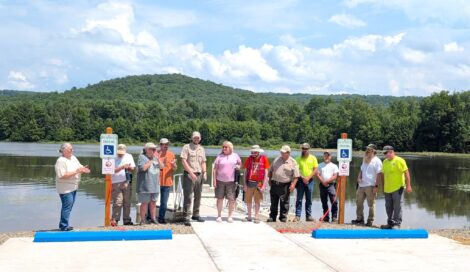Forest Service continues to use beetles to combat hemlock woolly adelgid

Danielle Celly, U.S. Forest Service State, Private and Tribal Forestry staff, prepared to release a biological control beetle on the Allegheny National Forest. The beetles are being used in conjunction with silver flies to combat the spread of hemlock woolly adelgid, a threat to eastern hemlock trees.
The U.S. Forest Service continues to use nature to fight nature in the ongoing struggle against hemlock woolly adelgid.
Over the summer, silver flies were released on the Allegheny National Forest.
Now, an additional round of beetles have been added to the effort.
“The release of approximately 1000 Laricobius nigrinus beetles occurred at a single site in the Bradford Ranger District near Baughman Run,” ANF Public Affairs Officer Christopher Leeser said.
“The release, made possible with beetles provided by Virginia Tech University, was conducted by the USFS State, Private, and Tribal Forestry organization alongside staff from Allegheny National Forest.”
HWA is a particular threat in Pennsylvania because it targets the state tree – eastern hemlock, according to the Department of Conservation and Natural Resources.
The invasive pest was introduced to Virginia from Japan in the 1950s and had been found in Pennsylvania by the 1960s, per DCNR. Discovery of HWA on the ANF is much more recent.
The DCNR says the HWA feeds on plant sap and can ultimately kill hemlocks or inflict conditions such as needle drop and branch dieback.
“Within its native range, HWA populations are kept in check by natural predators, and hemlocks are adapted to the insect,” Leeser said.
“In the eastern US, however, natural predators of HWA are absent, and native hemlocks are not adapted to the pest.”
One way to combat the species is what the ANF calls “biological controls.”
“Two species of beetles (Laricobius nigrinus and Laricobius osakensis), also native to Japan and the Pacific Northwest, are known for being abundant predators of HWA,” Leeser said. “These biocontrol beetles prey on the first generation of HWA each year, both HWA adults and eggs.”
He said the first use of beetles against HWA on the ANF was in 2019.
“Those beetles are now being relocated in small numbers to other prioritized areas of the forest for establishment,” he said. “Additionally, adult silver flies were released this spring, their larvae prey on HWA eggs throughout the adelgid’s laying season. When present on the same site in sufficient numbers, the three biological controls work in tandem for increased HWA predation across multiple lifecycle stages.”
These biological controls are just one way that HWA can be combatted.
One such response commenced with the ANF individually treating 830 trees against the pest in 2016.




